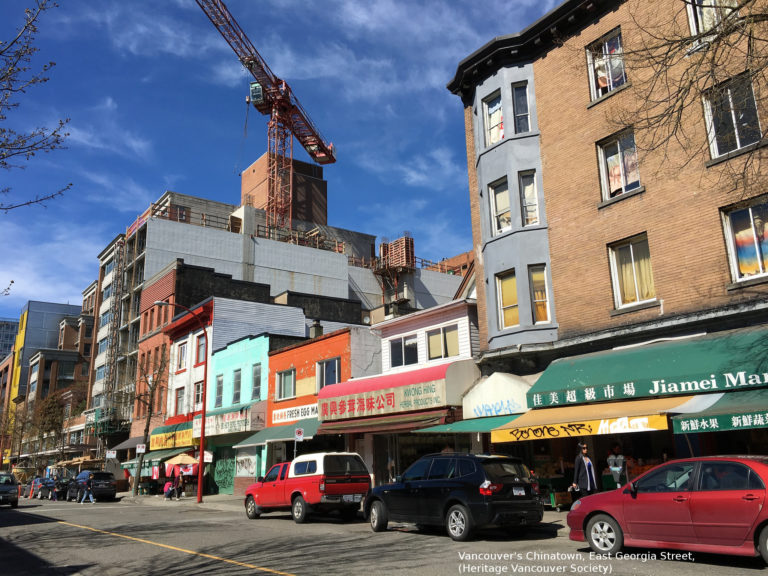“Inappropriate” Chinatown development designs drive gentrification

By Lisa Tanh
Newly proposed developments in Chinatown are using inappropriate designs to further gentrify the neighbourhood, says a neighbourhood advocate.
Melody Ma, a Chinese Canadian, said many of the newly proposed developments do not respect the neighborhood’s history and culture and that designs are centered around making profit.
“Architects and real estate developers seem to take on an oriental exoticism tokenistic approach when designing in Chinatown,” Ma claimed. “For example, they would slap on red or gold on facades, add oriental motifs or balconies and declare they’ve fulfilled design requirements in-line with Chinatown’s character.”
At an architecture presentation at Inform, Gair Williamson, an award-winning architect, proposed using gold and white colours for a Pender Street building. Ma claims when she asked Williamson why he used gold as the primary colour, he said “It is a colour used in Chinatown and that Chinese people working at his firm agreed.”
Ma said, “If you observe the use of gold in Chinatown or in the Chinese culture, it is typically never used as a primary colour, rather it is used as an accent colour.”
According to Ma, gold was traditionally tied to wealth and royalty in Chinese culture and reserved for imperial emperors. She added it was disrespectful for Williamson to use this colour since it would further gentrify the neighborhood.
Inge Roecker, an architect who lives in Chinatown, said she’s noticed more “hipster stores” opening up around the neighborhood.
“It’s changing so quickly and it’s so expensive,” Roecker said. “A good example is, you go over to Dalina and get a croissant for almost $5. You go over to the Chinese bakery and you can get three for $1.90 or something. It’s such an out-of-control difference.”
Roecker stressed that the developments bringing in these stores risk removing something unique to not just Chinatown — but all of Vancouver.
“It’s the merging of the shophouses with the Edwardian-style — a building type which just belongs to Vancouver,” Roecker said. “And so, I really feel like this is the heritage that we should preserve. A time piece of when the Chinese came mixed with what was here,” adding that the Mah Society and Lim Sai Hor Association buildings are two examples.
Tom Wanklin, a senior planner for the Downtown Eastside, said for the past three to four years, the city has been meeting with the public — from residents to architects and historians — for feedback on policies affecting the neighborhood.
“Once we’ve met with various groups and held the open meeting, we want to hear from our city manager as to what date he would take these proposals for a public hearing,” Wanklin said. “So we hope it will be held in the period of May, June or July – somewhere in that area.”
ThinkPol asked the city whether or not they will include Ma’s concerns in their proposals.
In an emailed statement, communications manager, Ellie Lambert, said “The city is asking that council approve amendments to the various zoning policies and design guidelines to better manage the pace and form of development in line with the priorities requested by numerous members of the community and organisations.
In the near future, we also intend embarking on a community engagement process to formulate a living heritage and cultural assets management plan to better protect intangible cultural assets. This process will consider the cultural significance of using architectural building treatments such as different colours, motifs and balconies.”
Currently, city is also asking the public to fill out their zoning survey[1]https://www.talkvancouver.com/S.aspx?s=470&r=fV504aN2rZ2fB1QO0Wp3ZT&so=true&fromdetect=1 which asks whether or not they should involve the community more in the review of new developments and whether or not they should review current design guidelines.
For Ma, a development that respects the neighborhood’s history and culture is one that does not tokenize Chinese culture or copy existing heritage buildings.
“Instead, a respectful development authentically draws inspiration from the neighbourhood’s culture, provides a contemporary reinterpretation of Chinatown’s historic character and helps the long-time community realize their aspirations for the neighbourhood,” Ma said.
References
| 1. | ↑ | https://www.talkvancouver.com/S.aspx?s=470&r=fV504aN2rZ2fB1QO0Wp3ZT&so=true&fromdetect=1 |



